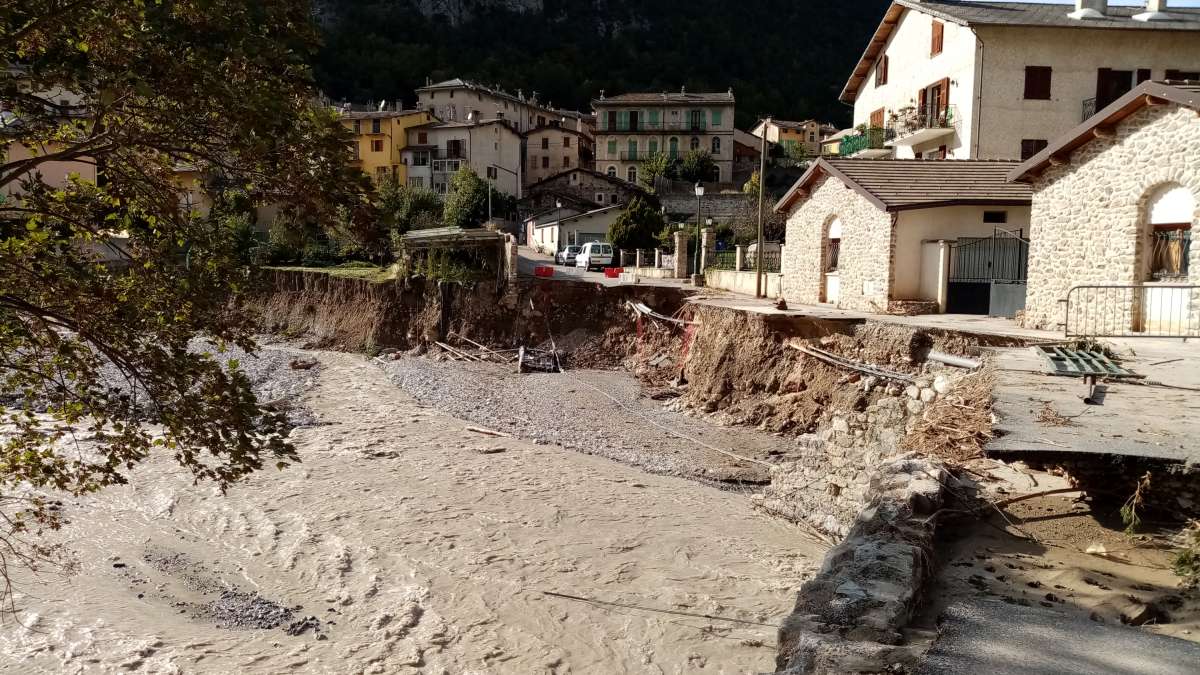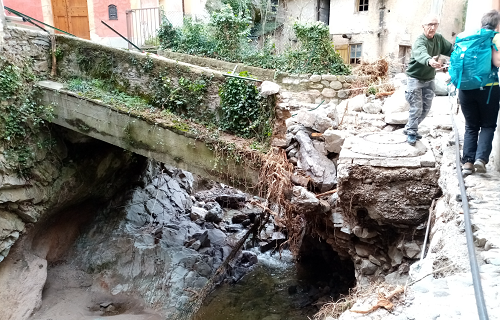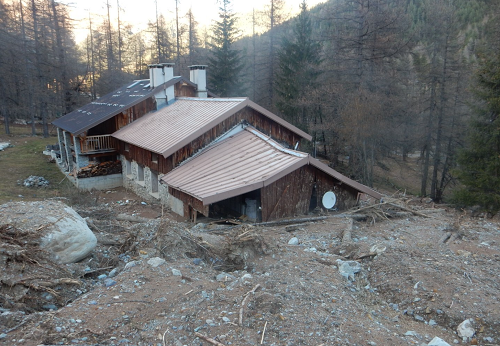
Storm Alex, which hit a mountainous area in early October 2020, caused major flooding in the valleys, where rivers overflowed their banks. Several towns were affected and infrastructure was partially destroyed, leaving several residential areas cut off. In particular, 85 km of roads were washed away (including 12 destroyed bridges) and 32 roads were cut off.
A wide range of skills were mobilised at Cerema the day after the event: geotechnics, civil engineering and infrastructure, natural hazards, construction, flood protection works, etc. For the past two years, some of these skills have been present during the reconstruction phase.
Engineering structures
Several engineering structures teams were mobilised, first to identify damage to structures, then to design and install emergency bridges to open up populated areas. The temporary bridge at Breil-sur-Roya was installed in February 2021 in five days by a specialist Cerema department.Cerema provided project management assistance to the Alpes-Maritimes departmental council for the design of two exceptional bowstring bridges, intended to replace two structures swept away by the flood: the Cairos and Ambo bridges, with occasional support during the works phase to assist with the supervision of the execution studies. This mission was carried out under particularly tight deadlines.
Support is now being provided for the reconstruction of the bourg neuf bridge at Tende (on the hydraulic and engineering structures aspects).
The emergency bridges have been installed in such a way as to withstand further bad weather, with a possible 400% increase in water flow.
These experiments were showcased at a technical day devoted to the resilience of engineering structures in May 2022.
Roads
Also for the Alpes-Maritimes departmental council, Cerema has been involved in the reconstruction of road infrastructure in the Roya valley, following the urgent works phase.
In mid-2022, Cerema carried out a survey of the roads using conventional measuring equipment, as well as innovative equipment (Aigle 3D, CereMap3D), with the aim of defining solutions for the works, taking into account the challenges of the circular economy and the resilience of the region.
Restoring access to the Col de Tende road tunnel:

Following Storm Alex, the infrastructure providing access to the Col de Tende road tunnel suffered extensive damage. Firstly, during the flooding of the Roya, the destruction of the access platform to the historic tunnel, then 24 to 48 hours after the flooding, the destruction of the two engineering structures (historic and recent) crossing the Ca valley, a few dozen metres from the heads of the two tunnel tubes.
Cerema's first task (in 2021) was to assess the feasibility of re-establishing access to the tubes, then (in 2022) to assist the DREAL PACA in validating the solutions proposed by the Italian project owner (delegate) and prime contractor for re-establishing access.
Cerema is involved in several capacities in these study phases:
- Engineering structures (crossing the Ca valley),
- Geometry of the route (particular context of connection with a tunnel)
- Geotechnical engineering (taking into account the risk of torrential lava, structure foundations, design of retaining structures in a context of recurring ground instability),
Frequent technical discussions are held with the Italian design offices in charge of the project's design.
The Fontan SNCF viaduct:
The Fontan viaduct is a major SNCF structure on line 946 between Cuneo and Ventimiglia (it is an arcature wall).
During storm Alex, this structure was hit by a large-scale landslide and affected by disorders that led to a geotechnical assessment (G5) carried out by Cerema Méditerranée. This diagnosis led to the development of a reinforcement sketch, which was used as a matter of urgency in the absence of surveys to save the structure.
Following this emergency reinforcement, Cerema is continuing to provide project management and periodic monitoring of the structure. As part of this work, it has implemented instrumentation using GPS beacons (Géocube) deployed in the slope on either side of the structure. This instrumentation complements the inclinometric monitoring, verifies the effectiveness of the reinforcement and validates the actual extent of the landslide.
Natural hazards
In order to integrate natural risks into the assessment of reconstruction projects, Cerema organised and led two participative workshops on territorial resilience with decision-makers from public services in the Alpes-Maritimes (local authorities and State services). The idea was to co-construct evaluation criteria for reconstruction projects based on a shared vision of resilience from the territorial level to that of the project and based on local issues. The use of the resilience compass, designed by Cerema and incorporating the 17 UN Sustainable Development Goals, ensures that all aspects of resilience have been taken into account.
Seven criteria shared by all stakeholders have been identified and used as input for the resilience committees:
Collective interest
Environmental impact and sobriety
Adaptability/reversibility
Risk reduction
Reproducibility
Feasibility
Utopia and dreams
Cerema also participated in the resilience evocation committees led by DDTM06 with MIRV (Interministerial Mission for the Reconstruction of the Valleys), Cerema, OFB, ONF-RTM (Mountain Land Restoration Department) and the Mercantour National Park. Their aim is to collectively ensure that development and infrastructure projects meet the requirements of resilience and sustainability, and that they are technically capable of withstanding future severe weather events.
The committee issues a formal opinion for each project receiving co-financing from the State, using the €100m budget earmarked for funding resilient infrastructure and projects as part of the State/community contractual agreement dedicated to reconstruction.
Hydrological study of flows
 Cerema has been commissioned by the State (DDTM06) to coordinate a hydrological survey. This work has made it possible to provide estimates of flood flows linked to storm Alex on the scale of the major valleys, based on the current state of knowledge of the parties involved. Although these estimates should be treated with caution, they nevertheless provide important information on the flood risk in the areas affected, so that events of this type can be better understood and prevented.
Cerema has been commissioned by the State (DDTM06) to coordinate a hydrological survey. This work has made it possible to provide estimates of flood flows linked to storm Alex on the scale of the major valleys, based on the current state of knowledge of the parties involved. Although these estimates should be treated with caution, they nevertheless provide important information on the flood risk in the areas affected, so that events of this type can be better understood and prevented.
Storm Alex caused intense and persistent rain in the Alpes-Maritimes on Friday October 2 until the middle of the night, before evacuating towards Italy. The rainfall during this episode was locally exceptional, lasting between 6 hours and 24 hours, and exceeded the maximum known in the Alpes-Maritimes and the Provence-Alpes-Côte-d'Azur region. With 663 mm in 24 hours at the Mesces station in the Roya basin, the event of October 2, 2020 joins the category of extreme events and historical records recorded in France around the Mediterranean.
The heavy rainfall, which was particularly intense in certain parts of the upper catchment areas, caused a rapid increase in flows, with peak flood levels reached in just a few hours. The study carried out quantified the flows at various points on the rivers affected by the event.
Feedback on ground movements
 This action has several objectives:
This action has several objectives:
- To establish a typology of the main ground movements that have occurred
- Qualify their degree of evolution
- To highlight the different parameters involved in triggering and developing these phenomena.
To do this, Cerema is regularly monitoring four landslides of significant size (in terms of volume or potential impact) and carrying out numerical processing to define and rank the various parameters that contributed to their occurrence (geological nature of the land, rainfall, slope, etc.). The report, drawn up on behalf of the DGPR, will be submitted in early 2023.
Cerema wishes to continue this feedback, by continuing to monitor the landslides identified over a longer period (5 years) and by analysing the phenomenon of gypsum dissolution (the cause of structural damage to buildings), which seems to have undergone changes following Storm Alex.
Building
 Cerema was asked by the DDTM immediately after the storm to:
Cerema was asked by the DDTM immediately after the storm to:
- Provide a pre-assessment of the damage to buildings (extent and nature) in the Roya valley: damage such as scouring of foundations, structural disorders, sediment deposition, gullying on land, damaged roofs, areas of gypsum dissolution, etc.
- Helping to size and direct the more in-depth emergency diagnostics to be carried out at a 2nd stage by the teams deployed on the ground (AFPS, Order of Architects, Metropolitan Council services, etc.)
- Assessing more specifically the damage suffered by the CHU and the EPHAD St Lazare de Tende (specific request from the COD - ARS - CHU) with a view to defining targeted expert appraisals if necessary.
Cerema is also providing support to government departments in connection with several expropriation procedures - acquisition of endangered property in two highly affected villages, Tende and Breil-sur-Roya. For example, the DDTM 06 was able to call on Cerema's expertise to determine whether a property was threatened in the more or less long term by a landslide hazard requiring a permanent ban on its occupation.

